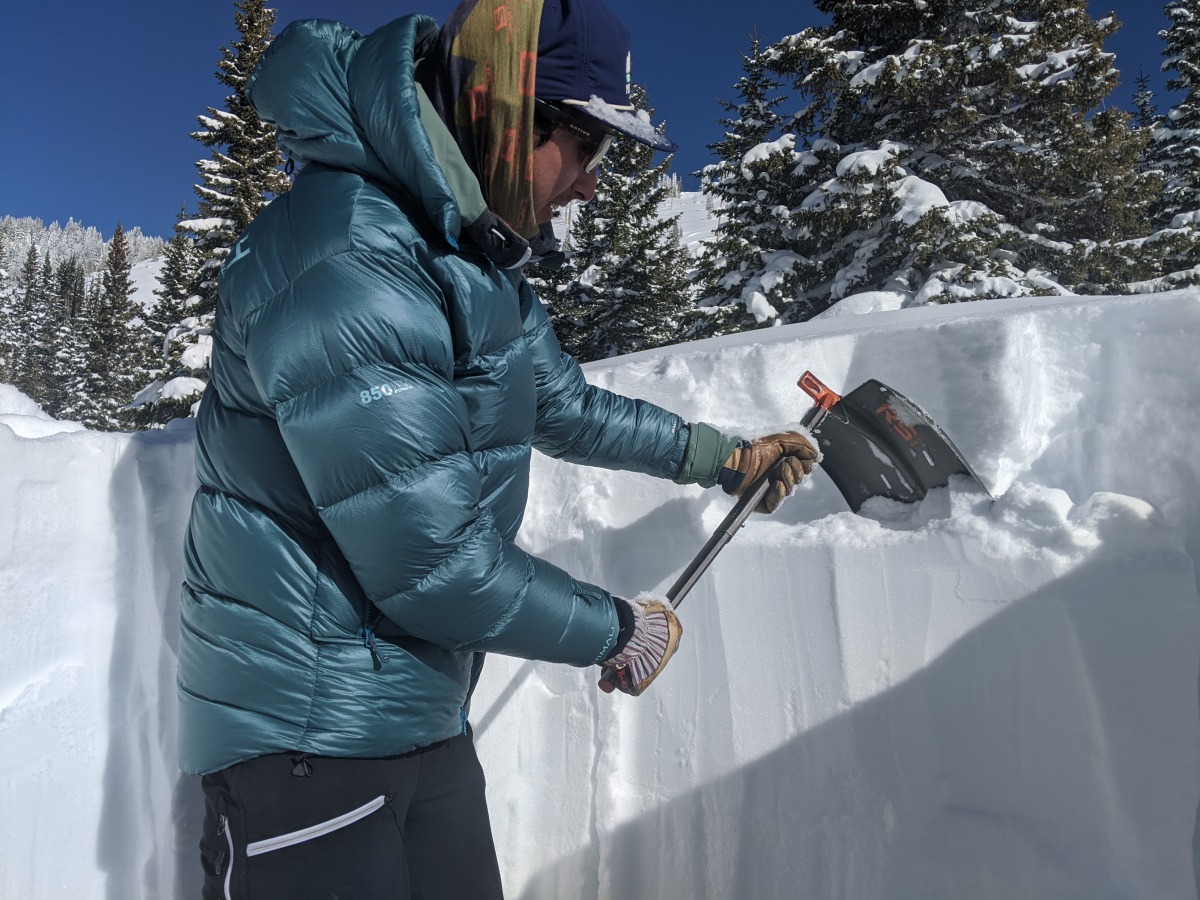
Hoe attachments offer important benefits to avalanche shovels, particularly when snow needs to be moved quickly. Photo: Aidan Goldie
In the years that I have been backcountry skiing, I have only owned two backcountry shovels. While an avalanche shovel will be perhaps that single most durable piece of backcountry gear in the kit, I decided to buy a new only a couple of seasons into backcountry skiing. There was nothing wrong with my original shovel, only it was missing a unique element — the hoe attachment, — that prompted me to leave my trusty metal shovel on the shelf and purchase the one in my pack today.
The replacement shovel has all of the necessary features: it collapses to store neatly in a backpack, is lightweight but durable, and has a larger metal shovel blade (9×11 inches) adept for moving large volumes of snow and performing standardized avalanche pit tests. The major thing that sets it apart from the variety of shovels I see backcountry travelers using is this: the hoe feature. But why is the hoe so great?
I developed a few small scientific trials to answer my question: does a hoe attachment increase the digging efficiency of a metal backcountry shovel? Here’s what I found.
What a hoe does and why it matters
The hoe feature on a shovel allows the user to change the angle of the shovel blade from being in-line with the handle to a 90-degree bend. This effectively provides the shovel with a significant mechanical advantage that will increase the effectiveness of the shovel handle as a lever arm to more effectively pry snow.
Of course, my anecdotal findings are not founded in anything more than opinion. But the ability to move more snow in the same amount of time could prove to be invaluable in a situation where seconds count, as in an avalanche rescue. In an average rescue scenario where a victim only has enough air for ten to fifteen minutes before succumbing to asphyxiation, any increase in digging efficiency could really prove to be the difference between a successful rescue and an unsuccessful one.
One hoe, three trials
In my small experiment, I identified three variables, the use of the hoe attachment, snow quality (fresh vs avalanche debris), and the digger themself. With one of my backcountry ski partners, we came across a recent slide and the pile of avalanche debris. Probing around, we found an average depth of about 160 cm. We set up a quick experiment. The objective was to dig down to the ground as quickly as possible. One person used a shovel in its standard configuration, and the other used the hoe attachment. Then we did the experiment again, switching shovels to control for differences in shoveling abilities. I replicated this experiment three times with three different partners.
After averaging the time that it took each individual to dig one meter down using each type of shovel configuration and controlling for individual digging ability, I had my results. In my informal scientific trials with a small sample size, I found that the backcountry skier using a shovel in hoe mode was able to move snow about twenty percent faster than their straight-shoveled counterpart. On average, a difference in time of 10.8 minutes versus 13.4 minutes.
There are a few reasons why a hoe configuration might confer to better digging ability. The mechanical advantage given by the hoe gives the digger the ability to pry the hard debris apart, something more challenging to do with a straight-handled shovel. The hoe configuration also makes it possible to swing down into the snow, transferring more power to break through debris blocks. This displaces energy away from critical digging muscles leading to a more efficient digging technique. A combination of these two factors makes it easier to cut through avalanche debris in particular, compared to undisturbed snow.
Conclusions
The twenty percent efficiency gained by using the hoe configuration in your backcountry shovel could translate to a rescuer moving the same amount of snow in twelve minutes with a hoe attachment than they would in fifteen minutes without. This may seem marginal, but avalanche rescues are a game of margins.
While there is a small scientific basis for this article, this is really a foundation for future backcountry skiers to build upon. The main takeaway is to practice your digging. Know your gear and work on your companion rescue. The gained efficiency you could gain by using the hoe attachment is lost without systematic rescue digging. Dedicate a day to practice with your regular touring partners. Find a parking lot where a snowplow has piled hardened snow that resembles avalanche debris and work on digging efficiently. Find out what ten minutes of digging feels like and just how physically exhausting it can be.
While I have made multiple sacrifices for the sake of weight and bulk in my touring pack, I haven’t compromised the size or ability of my backcountry shovel. This rescue item is not for me, after all, but for my touring partners. Carrying anything less than the best is a statement that I am not wholly committed to their rescue. These small trials helped me discover that using the hoe attachment on my shovel may better meet that standard of excellence, but in reality, the hoe and the digging practice made me a better touring partner.
Ready to upgrade your avalanche shovel? We particularly like BCA’s RS EXT and D2. We’ve gotten word that Mammut’s popular Alugator Lite shovel will include a hoe version next fall.

Aidan Goldie is a Basalt-based backcountry skier and photographer. When he is not climbing and descending peaks in the American West, he is an outdoor educator, working with schools and nonprofits guiding groups through the Colorado wilderness.
